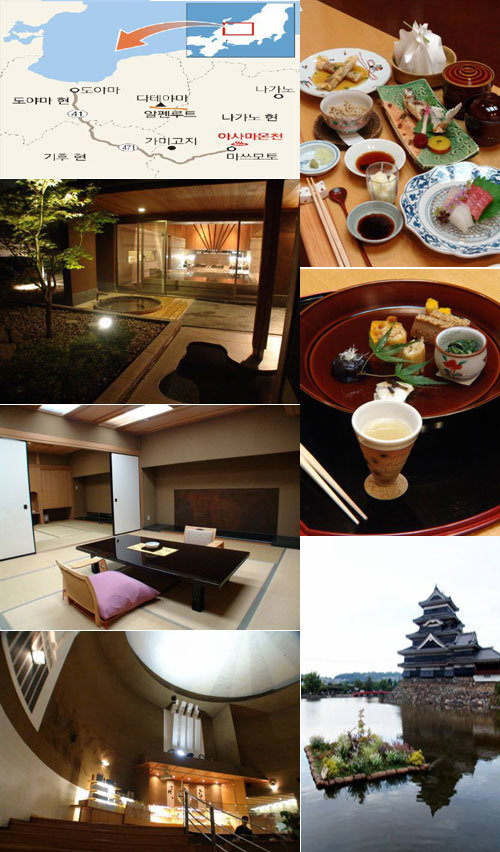A Designers Inn Tucked Away in Japans Alps
A Designers Inn Tucked Away in Japans Alps
Posted November. 09, 2007 07:50,

Nagano Prefecture is the home of Japans Alps. Just like its reputation, the area has mountains covered with snow. Walter Western (1861-1940), after his first visit in 1888 as an Anglican missionary and mountain climber and many other visits to the mountains, wrote a book titled, Climbing and Exploring Japans Alps, where he used the term Japans Alps for the first time.
The mountainous Nagano villages have many hot springs, which means there are many traditional inns as well. Indeed, the prefecture has as many inns as Hokkaido Island.
Kishoan, one of the inns at the Asama Spring, is an inn designed by a professional architect and is located downtown Matsumoto in Shinshu (the old name for the Nagano Prefecture). Its modern interior is a pleasant contrast with Matsumoto Street, and is a place where Japans traditional beauty can be savored.
A Beautiful Crow Palace-
Leaving for Matsumoto Shi in Shinshu from Doyama near the East Sea means traveling on a bumpy road. The road, National Highway 41 and Route 471, cuts diagonally across the Kita Alps (the northern range of the Japan Alps that divides Kita and Minami), leading to a remote valley west of a treacherous series of mountains called the Tateyama Range.
The Tateyama mountains dividing Doyama and Nagano prefectures are well known among Koreans due to Alpen Route climbers. They are the Japanese version of the Jungfraujoch (one of Switzerland`s most attractive railway excursion routes). The Alpen Route, one of the worlds most popular tourist destinations, enables people to travel to the Tateyama mountain ranges of the Kita Alps by train, highway, tunnel (trolley bus), and ropeway. The route connects the Kurobe Dam and an area containing mountain paths. A road alongside 20-meter high snowy walls (2,400m above sea level) on the Murodo Plateau near Doyama is the most enduring symbol of the Alpen Route.
After about four hours on the road (190km) west of the Tateyama Range, this reporter arrived at Matsumoto, sitting 600m above sea level. One of the landmarks in Matsumoto is the crow palace, or the Matsumoto Palace (a Japanese national treasure). The name crow palace comes from its high tower on top of the palace that is painted black. A double moat filled with water and constructed in order to protect the palace from enemies makes the palace look like it is floating on water. Cherry blossoms surrounding the palace that bloom in April are one of the reasons many people come here.
Kishoan is located in a quiet residential neighborhood set in a forest with pine trees about 10 minutes away by taxi from the palace. The first thing I saw was a round tower similar to the one overlooking Matsumoto Palace. It was impressive that an outer wall without any windows was decorated with protruding sculptures. A leaflet on the area called the structure The Designers Inn, and the structure indeed looked very artistic.
The interior of Kishoan will never cease to amaze visitors. After walking down a long corridor-like path where trees and grass were planted, an arch-shaped interior structure appeared. In the middle of a wall of the tower was a glass window, and outside of the tower was an atrium with a fountain. The atrium had no ceiling to bring sunlight indoors. Both sides of the fountain were occupied by restaurants, providing a beautiful view to guests of the inn.
The main architect of the inn is Takao Habuka, but six other architects were involved in building it. The design of the porch, lobby, corridor, restaurant patio, veranda, bathrooms, walls of the rooms, and the roof were assigned to these six architects. This is how Kishoan got the name Designers Inn.
There were so many things that caught my eye about the inn. Its ceiling, for instance, was decorated, and wooden porch doors of superior craftsmanship led to rooms and restaurants. A corridor named Gallery reminds people of pottery museums. Classy wall decorations and the use of traditional paper give the walls of the inn a natural feel. All these elements give the impression to guests that they are in a place of prestige.
World-class Services Available at Kishoan-
Okamas (female managers who oversee Japanese inns) are nowhere to be seen. Instead, a young man has the job, which has a profound meaning in Japanese culture. Under the Okami system, employees working under Okamas do their work only after they report to an Okami. In the Kishoan system, things work in the opposite way. Employees carry out what they think needs to be done, and report what they have done to their manager, so service is prompt and guests are satisfied. In order to make sure employees do their job, however, all the workers are trained to play a role of managers.
This system is the brainchild of Hoshino Yoshiharu, CEO of Hoshino Resort, which is modeled after the policies in place at the 103-year-old Hoshino Garuijawa (a new kind of inn at Garuijawa). Hoshino Resort is in charge of running Kishoan.
The twenty-six rooms at Kishoan all have Japanese floor mats, but guests can choose between 25 rooms without beds and one room with a bed. Fifteen rooms have an outdoor spa, while three have garden terraces. Guests eat at restaurants on the first and second floor, and eat Japanese traditional Kaiseki course meals for dinner. They can choose between Japanese or Western food for breakfast. The ten-course Kaiseki meal allows people to choose between steak or fish for their main dish, and different kinds of desserts. The food and the service at the restaurants was excellent.
People may think that a large outdoor spring is not necessary considering the plethora of smaller outdoor springs attached to some rooms. But big outdoor Jacuzzis usually have better views and people can relax and relieve their stress better when tubs are big.
Kishoan has two big outdoor springs with facilities that match those of other high-class inns in Japan. Spacious rooms and old pine tree floors add to their sophistication. What is more surprising is that as far back as ten years ago, Kishoan had all these luxurious facilities in place.
The majority of Kishoans guests are Japanese tourists who stop there on their way to visit Kamikoji (1505m). One of the most popular tourist spots in the Kita Alps, Kamikoji has an observatory where people can climb up via a ropeway. Tourists almost always visit Matusmoto Palace after visiting the observatory.
Not far from Kishoan is the Asama Golf Club, where people can enjoy great scenery while playing golf just 15 minutes away from Kishoan.
summer@donga.com






![“설거지해도 그대로”…냄비 ‘무지개 얼룩’ 5분 해결법 [알쓸톡]](https://dimg.donga.com/c/138/175/90/1/wps/NEWS/IMAGE/2026/01/15/133164664.3.png)
